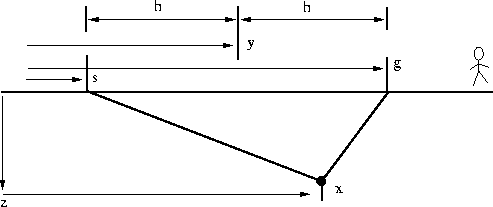




Next: Cheops' pyramid
Up: Dip and offset together
Previous: Dip and offset together
Prestack migration creates an image of the earth's reflectivity
directly from prestack data.
It is an alternative to
the ``exploding reflector'' concept
that proved so useful in zero-offset migration.
In prestack migration,
we consider both downgoing and upcoming waves.
A good starting point for discussing prestack migration is a reflecting
point within the earth.
A wave incident on the point from any direction
reflects waves in all directions.
This geometry is particularly important because
any model is a superposition of such point scatterers.
The point-scatterer geometry for a point
located at (x,z) is shown in Figure 1.
pgeometry
Figure 1
Geometry of a point scatterer.
|
|  |
 The equation
for travel time t is the sum of the two travel paths is
The equation
for travel time t is the sum of the two travel paths is
|  |
(1) |
We could model field data
with equation (1) by copying reflections from any point
in (x,z)-space into (s,g,t)-space.
The adjoint program would form an image stacked over
all offsets.
This process would be called prestack migration.
The problem here is that the real problem
is estimating velocity.
In this chapter we will see that it is not satisfactory
to use a horizontal layer approximation to estimate velocity,
and then use equation (1) to do migration.
Migration becomes sensitive to velocity when wide angles are involved.
Errors in the velocity would spoil whatever benefit could
accrue from prestack (instead of poststack) migration.





Next: Cheops' pyramid
Up: Dip and offset together
Previous: Dip and offset together
Stanford Exploration Project
12/26/2000

